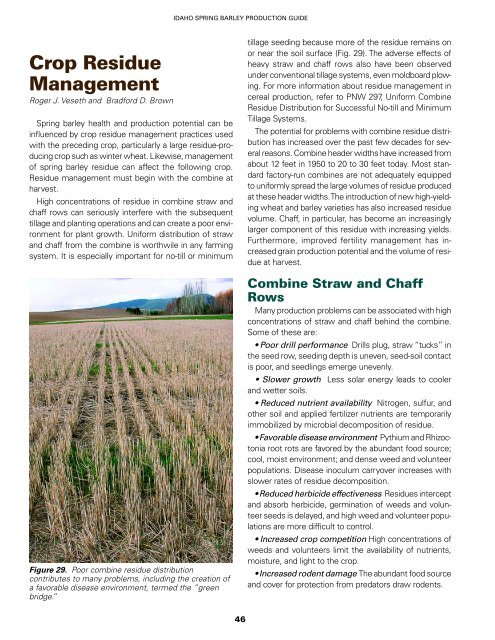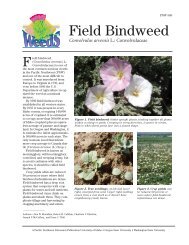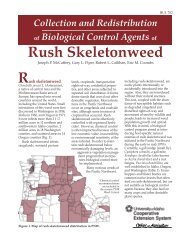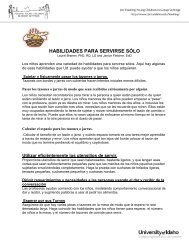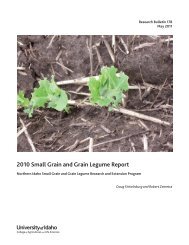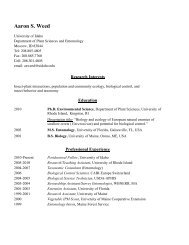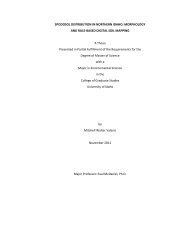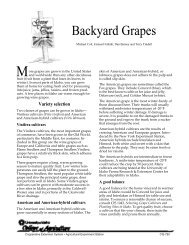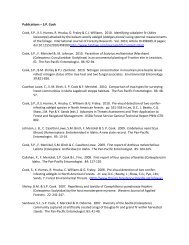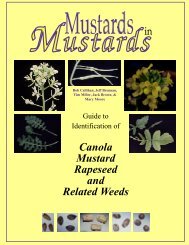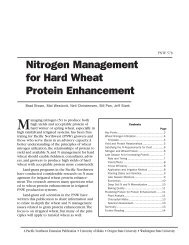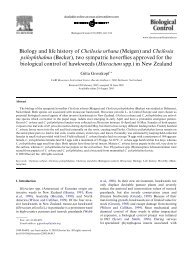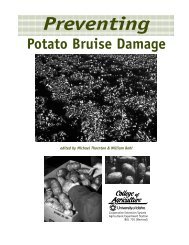Spring Barley Production Guide - College of Agricultural and Life ...
Spring Barley Production Guide - College of Agricultural and Life ...
Spring Barley Production Guide - College of Agricultural and Life ...
Create successful ePaper yourself
Turn your PDF publications into a flip-book with our unique Google optimized e-Paper software.
Crop Residue<br />
Management<br />
Roger J. Veseth <strong>and</strong> Bradford D. Brown<br />
<strong>Spring</strong> barley health <strong>and</strong> production potential can be<br />
influenced by crop residue management practices used<br />
with the preceding crop, particularly a large residue-producing<br />
crop such as winter wheat. Likewise, management<br />
<strong>of</strong> spring barley residue can affect the following crop.<br />
Residue management must begin with the combine at<br />
harvest.<br />
High concentrations <strong>of</strong> residue in combine straw <strong>and</strong><br />
chaff rows can seriously interfere with the subsequent<br />
tillage <strong>and</strong> planting operations <strong>and</strong> can create a poor environment<br />
for plant growth. Uniform distribution <strong>of</strong> straw<br />
<strong>and</strong> chaff from the combine is worthwile in any farming<br />
system. It is especially important for no-till or minimum<br />
Figure 29. Poor combine residue distribution<br />
contributes to many problems, including the creation <strong>of</strong><br />
a favorable disease environment, termed the ”green<br />
bridge.”<br />
IDAHO SPRING BARLEY PRODUCTION GUIDE<br />
46<br />
tillage seeding because more <strong>of</strong> the residue remains on<br />
or near the soil surface (Fig. 29). The adverse effects <strong>of</strong><br />
heavy straw <strong>and</strong> chaff rows also have been observed<br />
under conventional tillage systems, even moldboard plowing.<br />
For more information about residue management in<br />
cereal production, refer to PNW 297, Uniform Combine<br />
Residue Distribution for Successful No-till <strong>and</strong> Minimum<br />
Tillage Systems.<br />
The potential for problems with combine residue distribution<br />
has increased over the past few decades for several<br />
reasons. Combine header widths have increased from<br />
about 12 feet in 1950 to 20 to 30 feet today. Most st<strong>and</strong>ard<br />
factory-run combines are not adequately equipped<br />
to uniformly spread the large volumes <strong>of</strong> residue produced<br />
at these header widths. The introduction <strong>of</strong> new high-yielding<br />
wheat <strong>and</strong> barley varieties has also increased residue<br />
volume. Chaff, in particular, has become an increasingly<br />
larger component <strong>of</strong> this residue with increasing yields.<br />
Furthermore, improved fertility management has increased<br />
grain production potential <strong>and</strong> the volume <strong>of</strong> residue<br />
at harvest.<br />
Combine Straw <strong>and</strong> Chaff<br />
Rows<br />
Many production problems can be associated with high<br />
concentrations <strong>of</strong> straw <strong>and</strong> chaff behind the combine.<br />
Some <strong>of</strong> these are:<br />
• Poor drill performance Drills plug, straw “tucks” in<br />
the seed row, seeding depth is uneven, seed-soil contact<br />
is poor, <strong>and</strong> seedlings emerge unevenly.<br />
• Slower growth Less solar energy leads to cooler<br />
<strong>and</strong> wetter soils.<br />
• Reduced nutrient availability Nitrogen, sulfur, <strong>and</strong><br />
other soil <strong>and</strong> applied fertilizer nutrients are temporarily<br />
immobilized by microbial decomposition <strong>of</strong> residue.<br />
• Favorable disease environment Pythium <strong>and</strong> Rhizoctonia<br />
root rots are favored by the abundant food source;<br />
cool, moist environment; <strong>and</strong> dense weed <strong>and</strong> volunteer<br />
populations. Disease inoculum carryover increases with<br />
slower rates <strong>of</strong> residue decomposition.<br />
• Reduced herbicide e fectiveness Residues intercept<br />
<strong>and</strong> absorb herbicide, germination <strong>of</strong> weeds <strong>and</strong> volunteer<br />
seeds is delayed, <strong>and</strong> high weed <strong>and</strong> volunteer populations<br />
are more difficult to control.<br />
• Increased crop competition High concentrations <strong>of</strong><br />
weeds <strong>and</strong> volunteers limit the availability <strong>of</strong> nutrients,<br />
moisture, <strong>and</strong> light to the crop.<br />
• Increased rodent damage The abundant food source<br />
<strong>and</strong> cover for protection from predators draw rodents.


